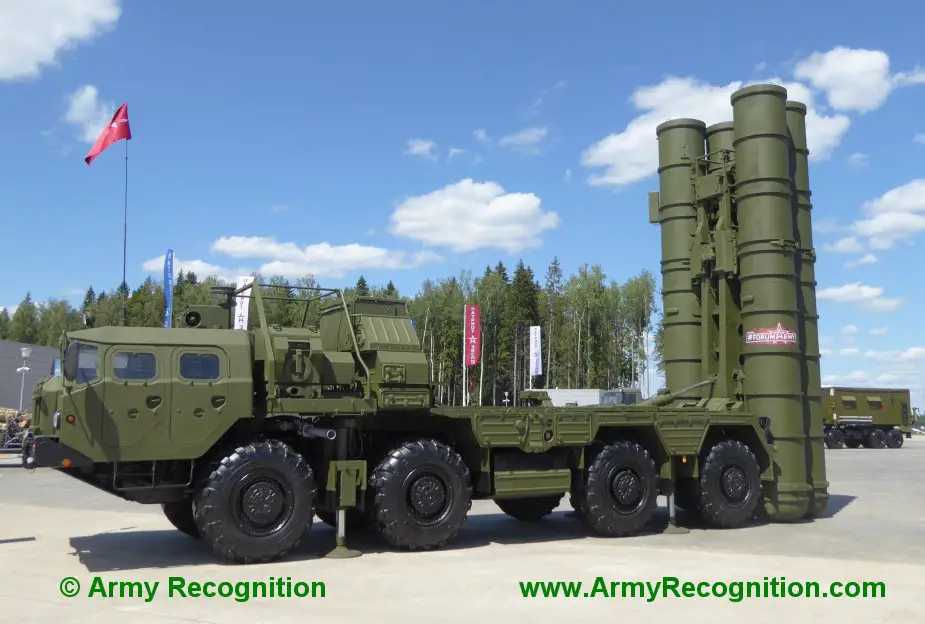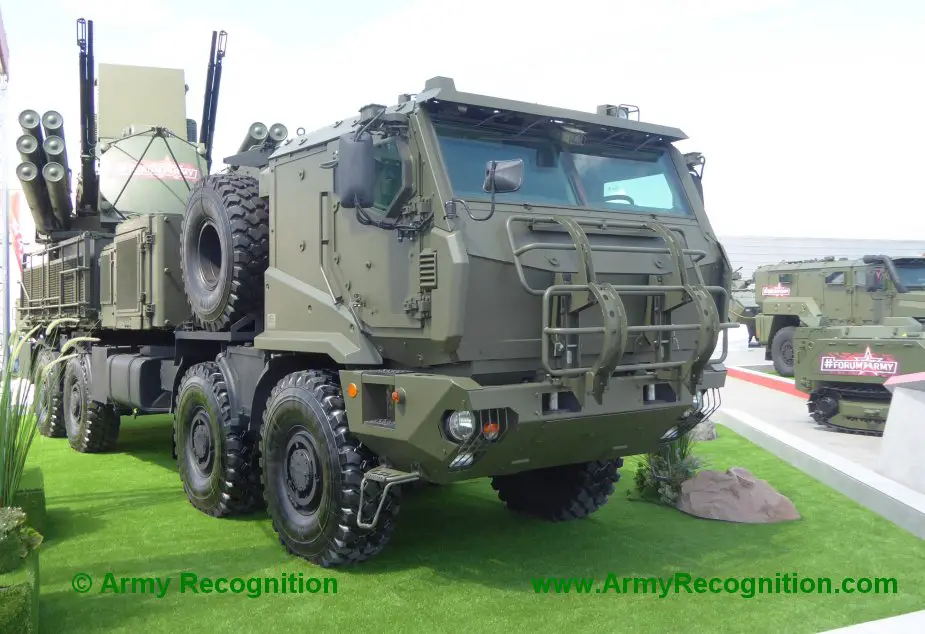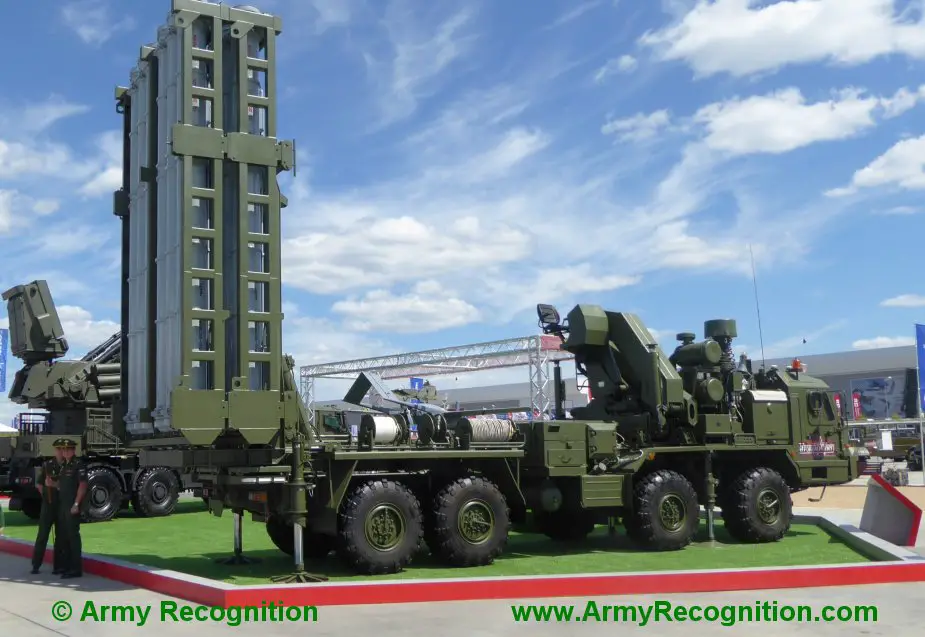Analysis: Russia develops antiaircraft missile forces
Until 1998, the Russian antiaircraft missile troops were subordinated to the air and missile defense forces. Today, they are a major component of the Russian Aerospace Forces. The latest S-350 Vityaz and Pantsir-SM participated in the latest Victory Day parade together with traditional S-400 and Pantsir-S guns, the Independent Military Review writes.
Follow Army Recognition on Google News at this link
S-400 Triumf air defense system (Picture source: Army Recognition)
The antiaircraft forces defend state and military command bodies, military groupings and important industrial and economic facilities from aerospace attacks. The realities of modern wars radically changed the range of targets for antiaircraft forces. Besides traditional airplanes, helicopters, cruise missiles, they have to destroy hypersonic weapons and intermediate-range ballistic missiles.
The troops have been actively developing of late. The media reported that S-400 and Pantsir were being supplied and S-500 Prometheus was being designed. Two years ago, Deputy Commander-in-Chief of the Aerospace Forces, Lieutenant-General Viktor Gumenny, said the share of modern weapons would not be less than 70 percent by January 1, 2021, in the air and missile defense.
S-300 and S-400
S-400 Triumf and Pantsir will remain the main weapons of the antiaircraft forces in the coming years. The Aerospace Forces operate close to 30 antiaircraft regiments armed with S-400. The Defense Ministry annually receives from Almaz-Antey Corporation at least two battalion sets of the latest air defense system. S-400 supplies have been going ahead of schedule in the past several years. In March 2020, Almaz-Antey said it supplied a regimental set of S-400 ahead of schedule. The ceremony was held at Kapustin Yar range in the Astrakhan region.
The range of S-400 missiles was expanded two years ago, in October 2018. Long-range guided 40N6 missile joined it. It can intercept air and reportedly ballistic targets at a distance of 400 km. TASS said the arms program up to 2027 envisages the procurement of over 1,000 of the latest missiles. All S-400s supplied to the Aerospace Forces are mobile. They are carried by all-terrain MZKT-543M tracked vehicles. By 2011, the Defense Ministry received three towed S-400 regiments deployed in the Moscow region. The launchers mounted on trailers were towed by Voshchina BAZ prime movers. By 2016, only towed S-400 participated in parades on Red Square.
Mobile S-400s were deployed in late 2015 at Humaymim airbase in Syria. The Russian military decided to reinforce the airpower with the latest antiaircraft weapons after Turkey downed a Russian Sukhoi Su-24M frontline bomber. S-400s were airlifted by Antonov An-124 aircraft. The latest photos of the Russian army show the first three regiments of towed S-400s have fully switched to mobile launchers.
S-400 Triumf predecessor – S-300PS, S-300PM, and S-300PT modifications – will continue to operate in the antiaircraft force for some time. They are being gradually replaced, but continue to defend important directions. In particular, an S-300 battalion is deployed in Abkhazia. The Defense Ministry said in October 2019 that S-300PS joined the 201st Russian military base in Tajikistan.
Not the whole S-300 family will be replaced. S-300PM-2 will be kept. Its supplies began in 2015. The Strela publication of Almaz-Antey said in January 2016 that the first regiment of these weapons went on combat duty in the Moscow region. S-300PM-2s are actively supplied to the troops. The Defense Ministry said that the antiaircraft missile regiment of the Central Military District deployed in the Irkutsk region would receive upgraded S-300PM-2 Favorite missiles by the end of 2020. It also said the military air defense school in Yaroslavl completed training of operators for S-300PM-2 regiment of the Leningrad air force and defense army of the Western Military District.
The ministry has not officially announced procurement plans for S-300PM-2 systems. They are likely to serve until 2025-2027 and will be replaced by S-400 Triumf.
The Strela said S-300PM-2 is a development of the S-300PM family. The weapons got upgraded detection radar, target illumination stations, and a mobile command post. The launchers are also upgraded and can fire S-400 missiles. S-300PM-2s are produced in mobile and towed options. The latter is towed by MAZ-0547 prime mover.
Pantsir-SM missile/gun air defense system (Picture source: Army Recognition)
Pantsir missile/gun air defense system
Pantsir missile/gun air defense systems are another important component of the Aerospace Forces. S-400 and S-300PM-2 regiments have one Pantsir battalion each to defend the long-range launchers against drones, cruise missiles and other precision weapons. Pantsir has also to defend S-400 and S-300 against ground attacks. Repulsion of ground attacks is an obligatory training element for Pantsir units.
Since 2020, the Defense Ministry has been forming mobile reserve regiments armed with Pantsirs. In 2019, the first experimental regiment was created in the special air and missile defense army to protect Moscow and the surrounding region from air attacks. The Defense Ministry said the regiment successfully trained live fire at Kapustin Yar range in the spring of 2020. It was reported in July that another unit would join the 14th Air Force and Defense Army. It will be deployed in the Urals. It is likely that each air force and defense army will have such a regiment.
The recent experience in the Syrian city of Idleb shows that Pantsir is most effective in modern conflicts. Syrian government forces sustained numerous losses from drone attacks before Pantsir was engaged and stopped them. The Syrian conflict exposed problems with Pantsir engagement. Single launchers quickly exhaust the round of munitions and become an easy target. In May 2018, the Israeli military detected an empty Pantsir and destroyed it. The situation happened again in 2019.
A Pantsir-S battalion can repel a strike similar to the one delivered by the United States at Shayrat airbase in 2017. Several dozen missiles were fired. Pantsir’s firepower is sufficient to defend two-three targets like Shayrat. The latest Pantsir-SM will be soon supplied to the Russian antiaircraft forces.
S-350 Vityaz air defense system (Picture source: Army Recognition)
S-350 Vityaz
In 2020, the Aerospace Forces received the first set of S-350 Vityaz systems. The Defense Ministry said in February the launchers had arrived in the antiaircraft training center in Gatchina and trained to detect and destroy the adversary. The ministry plans to procure over 140 S-350. In February 2020, Central Military District Commander Colonel-General Alexander Lapin said the 24th brigade deployed in Abakan in Khakassia would be rearmed with Vityaz by the end of 2022 followed by the regiment in Krasnoyarsk region. Vityaz has a high all-terrain capability. It can drive cross-country, in snow and sand and forge small rivers.
The 24th Brigade was formed in 2017 and is currently armed with S-300PS. In wartime, the brigade abandons the permanent deployment place and operates by separate battalions. The mission is to protect strategic facilities in the Krasnoyarsk region, Khakassia and Altai.
Thus, each air force and defense army is likely to have a regiment or brigade armed with Vityaz. The units will have the same mission as mobile reserve regiments. They will advance to the assigned area to defend important facilities. Pantsir regiments will defend individual objects, such as airfields, enterprises, bridges, headquarters and command posts, while Vityaz regiments/brigades will defend whole cities and areas. S-350s are highly mobile and can create aerospace defense even in the most complicated terrain.
Aviation always has an edge in the fight against air defense. The adversary can accumulate aircraft and drones and strike with cruise, ballistic and hypersonic missiles at less protected targets. The Syrian experience shows that scattered and intensive strikes can split the air defense and gradually destroy it.
To prevent such scenarios, the antiaircraft forces are creating mobile reserve regiments and units with S-350 Vityaz. They effectively and rapidly protect facilities against aerospace strikes and make it difficult to deliver concentrated strikes at poorly protected targets specifically if aircraft and drones encounter S-350 and Pantsir-SM battalions on their way, the Independent Military Review said.
© Copyright 2020 TASS / Army Recognition Group SPRL. All rights reserved. This material may not be published, broadcast, rewritten or redistributed.





























